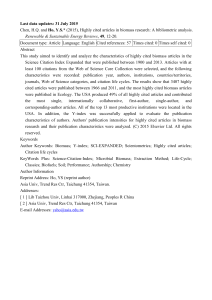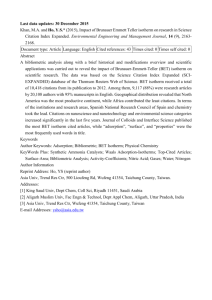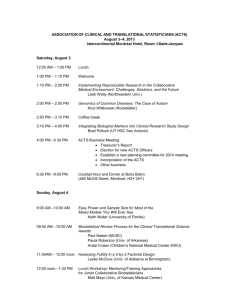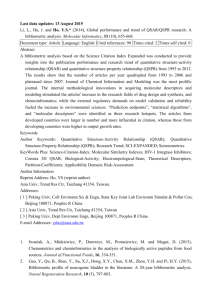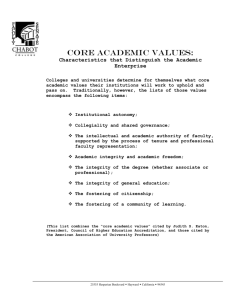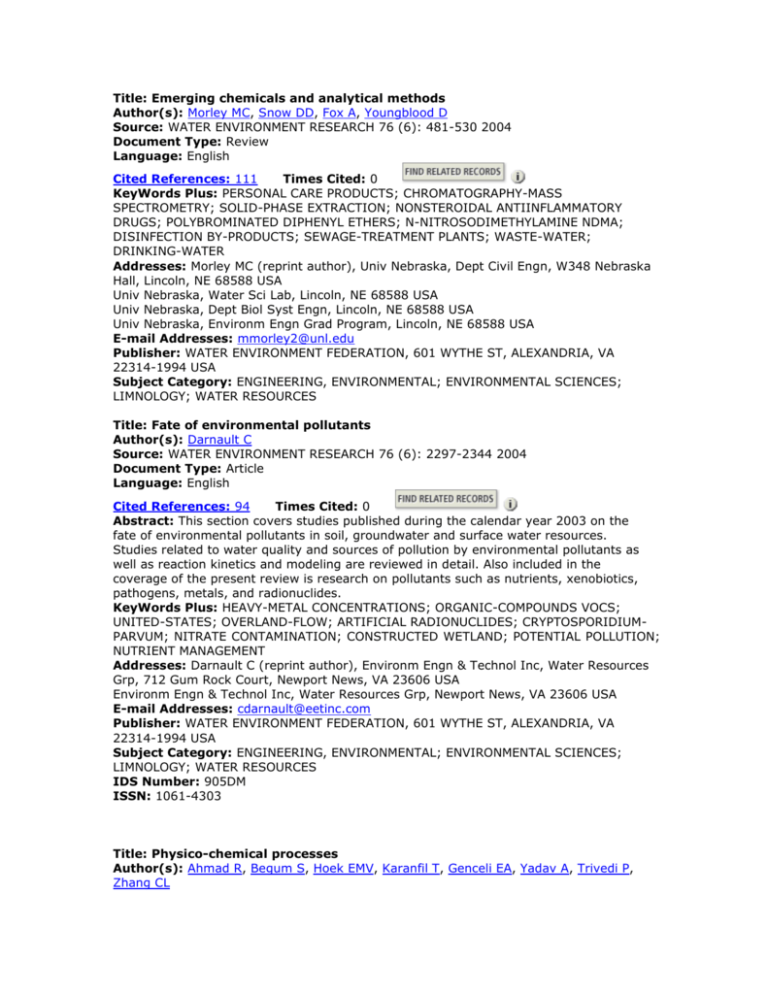
Title: Emerging chemicals and analytical methods
Author(s): Morley MC, Snow DD, Fox A, Youngblood D
Source: WATER ENVIRONMENT RESEARCH 76 (6): 481-530 2004
Document Type: Review
Language: English
Cited References: 111
Times Cited: 0
KeyWords Plus: PERSONAL CARE PRODUCTS; CHROMATOGRAPHY-MASS
SPECTROMETRY; SOLID-PHASE EXTRACTION; NONSTEROIDAL ANTIINFLAMMATORY
DRUGS; POLYBROMINATED DIPHENYL ETHERS; N-NITROSODIMETHYLAMINE NDMA;
DISINFECTION BY-PRODUCTS; SEWAGE-TREATMENT PLANTS; WASTE-WATER;
DRINKING-WATER
Addresses: Morley MC (reprint author), Univ Nebraska, Dept Civil Engn, W348 Nebraska
Hall, Lincoln, NE 68588 USA
Univ Nebraska, Water Sci Lab, Lincoln, NE 68588 USA
Univ Nebraska, Dept Biol Syst Engn, Lincoln, NE 68588 USA
Univ Nebraska, Environm Engn Grad Program, Lincoln, NE 68588 USA
E-mail Addresses: mmorley2@unl.edu
Publisher: WATER ENVIRONMENT FEDERATION, 601 WYTHE ST, ALEXANDRIA, VA
22314-1994 USA
Subject Category: ENGINEERING, ENVIRONMENTAL; ENVIRONMENTAL SCIENCES;
LIMNOLOGY; WATER RESOURCES
Title: Fate of environmental pollutants
Author(s): Darnault C
Source: WATER ENVIRONMENT RESEARCH 76 (6): 2297-2344 2004
Document Type: Article
Language: English
Cited References: 94
Times Cited: 0
Abstract: This section covers studies published during the calendar year 2003 on the
fate of environmental pollutants in soil, groundwater and surface water resources.
Studies related to water quality and sources of pollution by environmental pollutants as
well as reaction kinetics and modeling are reviewed in detail. Also included in the
coverage of the present review is research on pollutants such as nutrients, xenobiotics,
pathogens, metals, and radionuclides.
KeyWords Plus: HEAVY-METAL CONCENTRATIONS; ORGANIC-COMPOUNDS VOCS;
UNITED-STATES; OVERLAND-FLOW; ARTIFICIAL RADIONUCLIDES; CRYPTOSPORIDIUMPARVUM; NITRATE CONTAMINATION; CONSTRUCTED WETLAND; POTENTIAL POLLUTION;
NUTRIENT MANAGEMENT
Addresses: Darnault C (reprint author), Environm Engn & Technol Inc, Water Resources
Grp, 712 Gum Rock Court, Newport News, VA 23606 USA
Environm Engn & Technol Inc, Water Resources Grp, Newport News, VA 23606 USA
E-mail Addresses: cdarnault@eetinc.com
Publisher: WATER ENVIRONMENT FEDERATION, 601 WYTHE ST, ALEXANDRIA, VA
22314-1994 USA
Subject Category: ENGINEERING, ENVIRONMENTAL; ENVIRONMENTAL SCIENCES;
LIMNOLOGY; WATER RESOURCES
IDS Number: 905DM
ISSN: 1061-4303
Title: Physico-chemical processes
Author(s): Ahmad R, Begum S, Hoek EMV, Karanfil T, Genceli EA, Yadav A, Trivedi P,
Zhang CL
Source: WATER ENVIRONMENT RESEARCH 76 (6): 823-1002 2004
Document Type: Review
Language: English
Cited References: 491
Times Cited: 0
KeyWords Plus: WASTE-WATER TREATMENT; ZERO-VALENT IRON; ACTIVATED
CARBON ADSORPTION; WET AIR OXIDATION; AGRICULTURAL DRAINAGE WATER;
HYDROXYL RADICAL GENERATION; PARTICLE-SIZE DISTRIBUTION; HYDROPHOBIC
COTTON FIBERS; REVERSE-OSMOSIS MEMBRANES; OZONE-ENHANCED OXIDATION
Addresses: Ahmad R (reprint author), KHAFRA Engn Consultants Inc, 230 Peachtree St
200, Atlanta, GA 30303 USA
KHAFRA Engn Consultants Inc, Atlanta, GA 30303 USA
Georgia Inst Technol, Atlanta, GA 30332 USA
Univ Calif Riverside, Dept Chem & Environm Engn, Riverside, CA 92521 USA
Clemson Univ, Dept Environm Engn, Clemson, SC 29631 USA
Univ Alaska Fairbanks, Dept Civil & Environm Engn, Fairbanks, AK 99775 USA
Univ Houston Clear Lake City, Dept Environm Sci, Houston, TX 77058 USA
Publisher: WATER ENVIRONMENT FEDERATION, 601 WYTHE ST, ALEXANDRIA, VA
22314-1994 USA
Subject Category: ENGINEERING, ENVIRONMENTAL; ENVIRONMENTAL SCIENCES;
LIMNOLOGY; WATER RESOURCES
Title: A perspective of riverbank filtration
Author(s): Ray C, Grischek T, Schubert J, Wang JZ, Speth TF
Source: JOURNAL AMERICAN WATER WORKS ASSOCIATION 94 (4): 149-+ APR 2002
Document Type: Article
Language: English
Cited References: 35
Times Cited: 6
Abstract: Riverbank filtration (RBF) is a process In hili pumping wells located along
riverbanks induce a portion of the river water to flow toward the wells. During RBF, which
has many similarities to slow-sand filtration, river water contaminants are attenuated
from a combination of processes such as filtration, microbial degradation, sorption to
sediments and aquifer sand, and dilution with background groundwater.
RBF systems have been operating in Europe since the 1870s. In the United States, there
has been renewed interest among large- to medium-sized utilities to use It as a
mechanism of water production to reduce treatment costs and to meet regulations on
pathogens, disinfection by-products, and other contaminants under the Surface Water
Treatment Rule.
Although filtrate water quality from RBF systems can vary based on river conditions, it is
possible that appropriately designed systems; can serve as pretreatment for drinking
water, and at the same time, the utility can receive log-removal credits for pathogens
and particle,. In addition, RBF can be used as a pretreatment for membrane filtration.
In the United States, a knowledge gap exists oil the benefits and limitations of using RBF.
This article addresses those gaps, outlining the benefits and limitations of the process. It
also illustrates that RBF can be a viable alternative to surface water at suitable sites.
KeyWords Plus: WATER; INFILTRATION; ELBE
Addresses: Ray C (reprint author), Univ Hawaii Manoa, Dept Civil Engn, 2540 Dole St,
Honolulu, HI 96822 USA
Univ Hawaii Manoa, Dept Civil Engn, Honolulu, HI 96822 USA
Tech Univ Dresden, Inst Water Chem, Dresden, Germany
Stadtwerke Dusseldorf AG, Dusseldorf, Germany
Louisville Water Co, Louisville, KY USA
US EPA, Water Supply & Water Resources Div, Cincinnati, OH 45268 USA
Title: Riverbank filtration - An overview
Author(s): Kuehn W, Mueller U
Source: JOURNAL AMERICAN WATER WORKS ASSOCIATION 92 (12): 60-+ DEC 2000
Document Type: Article
Language: English
Cited References: 12
Times Cited: 16
Abstract: Bank filtration is the process that occurs when river water passes through the
river's banks and proceeds to the groundwater table. Natural riverbank filtration has
long been recognized as a water treatment. Many substances present in surface water,
such as natural organic matter or biodegradable micropollutants, are largely and in most
cases completely removed by bank filtration. Furthermore, bank filtration is able to
compensate for concentration or temperature peaks and provides protection against
shock loads. Bank filtration is so effective in treating river water and offers so many
additional benefits that it can replace or support treatment steps in a water plant.
Although not widely used by utilities in the United States, bank filtration has been
successfully practiced by German water providers for many years. Their experience
indicates that bank filtration is a suitable technology for river water under certain
conditions. Because it replaces or supports other treatment, bank filtration can help
reduce costs for utilities using river water. Because it is a natural process, bank filtration
wins support from consumers who want safe, but not highly treated, drinking water
supplies.
Addresses: Kuehn W (reprint author), DVGW Water Technol Ctr, Karlsruher Str 84,
Karlsruhe, D-76139 Germany
DVGW Water Technol Ctr, Karlsruhe, D-76139 Germany
Publisher: AMER WATER WORKS ASSOC, 6666 W QUINCY AVE, DENVER, CO 80235 USA
Title: The promise of bank filtration
Author(s): Tufenkji N, Ryan JN, Elimelech M
Source: ENVIRONMENTAL SCIENCE & TECHNOLOGY 36 (21): 422A-428A NOV 1 2002
Document Type: Article
Language: English
Cited References: 47
Times Cited: 13
KeyWords Plus: GROUND-WATER; RIVER WATER; ORGANIC-MATTER; INFILTRATION;
AQUIFER; BEHAVIOR; QUALITY; SWITZERLAND; MIGRATION; TRANSPORT
Addresses: Tufenkji N (reprint author), Yale Univ, New Haven, CT 06520 USA
Yale Univ, New Haven, CT 06520 USA
Univ Colorado, Boulder, CO 80309 USA
Title: MULHEIM PROCESS
Author(s): SONTHEIMER H, HEILKER E, JEKEL MR, NOLTE H, VOLLMER FH
Source: JOURNAL AMERICAN WATER WORKS ASSOCIATION 70 (7): 393-396 1978
Document Type: Article
Language: English
Cited References: 15
Times Cited: 59
Addresses: SONTHEIMER H (reprint author), UNIV KARLSRUHE, ENGLER BUNTE INST,
DEPT WATER CHEM, KARLSRUHE, D-7500 FED REP GER
RHEIN WESTFAL TH AACHEN, WASSERWERK GESELL, AACHEN, D-5100 FED REP GER
Publisher: AMER WATER WORKS ASSOC, 6666 W QUINCY AVE, DENVER, CO 80235
Subject Category: ENGINEERING, CIVIL; WATER RESOURCES
Title: EXPERIENCE WITH RIVERBANK FILTRATION ALONG THE RHINE RIVER
Author(s): SONTHEIMER H
Source: JOURNAL AMERICAN WATER WORKS ASSOCIATION 72 (7): 386-390 1980
Document Type: Article
Language: English
Cited References: 8
Times Cited: 26
Addresses: UNIV KARLSRUHE, ENGLER BUNTE INST, KARLSRUHE, D-7500 FED REP GER
Publisher: AMER WATER WORKS ASSOC, 6666 W QUINCY AVE, DENVER, CO 80235
Subject Category: ENGINEERING, CIVIL; WATER RESOURCES
Title: Environmental impact and mechanisms of the biological clogging of
saturated soils and aquifer materials
Author(s): Baveye P, Vandevivere P, Hoyle BL, DeLeo PC, de Lozada DS
Source: CRITICAL REVIEWS IN ENVIRONMENTAL SCIENCE AND TECHNOLOGY 28 (2):
123-191 1998
Document Type: Review
Language: English
Cited References: 244
Times Cited: 41
Abstract: The biological clogging of natural porous media, often in conjunction with
physical or chemical clogging, is encountered under a wide range of conditions.
Wastewater disposal, artificial groundwater recharge, in situ bioremediation of
contaminated aquifers, construction of water reservoirs, or secondary oil recovery are all
affected by this process. The present review provides an overview of the techniques that
are used to study clogging in the laboratory, or to monitor it in field applications. After a
brief survey of the clogging patterns most commonly observed in practice, and of a
number of physical and chemical causes of clogging, the various mechanisms by which
microorganisms dog soils and other natural porous media are analyzed in detail. A critical
assessment is also provided of the few mathematical models that have been developed in
the last few years to describe the biological clogging process. The overall conclusion of
the review is that although information is available on several aspects of the biological
clogging of natural porous media, further research is required to predict its extent
quantitatively in a given situation. This is particularly true in cases that involve
complicating factors such as predation or competition among organisms.
Author Keywords: bioremediation; groundwater; soil; hydraulic conductivity; artificial
recharge; bacteria; microorganisms; subsurface environment
KeyWords Plus: SCANNING ELECTRON-MICROSCOPY; HYDRAULIC CONDUCTIVITY;
POROUS-MEDIA; EXOPOLYSACCHARIDE PRODUCTION; ARTIFICIAL RECHARGE; SAND
COLUMNS; METHANOSARCINA-BARKERI; MATHEMATICAL-MODELS; PHYSICALPROPERTIES; SANDSTONE CORES
Title: Human pharmaceuticals in wastewater treatment processes
Author(s): Jones OAH, Voulvoulis N, Lester JN
Source: CRITICAL REVIEWS IN ENVIRONMENTAL SCIENCE AND TECHNOLOGY 35 (4):
401-427 2005
Document Type: Review
Language: English
Cited References: 133
Times Cited: 0
Abstract: The presence of human pharmaceutical compounds in surface waters is an
emerging issue in environmental science. In this study the occurrence and behavior of
human pharmaceuticals in a variety of wastewater treatment processes is reviewed.
Although some groups are not affected by sewage treatment processes others are
amenable to degradation, albeit incomplete. While water purification techniques such as
granular activated carbon could potentially remove these pollutants from wastewater
streams, the high cost involved suggests that more attention should be given to the
potential for the optimization of current treatment processes, and reduction at source in
order to reduce environmental contamination.
Author Keywords: fate; pharmaceuticals; pollution; sewage treatment plants;
wastewater
KeyWords Plus: SEWAGE-TREATMENT PLANTS; PERSONAL CARE PRODUCTS;
FLUOROQUINOLONE ANTIBACTERIAL AGENTS; CHROMATOGRAPHY-MASS
SPECTROMETRY; RAY CONTRAST-MEDIA; IN-GROUND WATER; AQUATIC ENVIRONMENT;
DRINKING-WATER; MUNICIPAL SEWAGE; STEROID ESTROGENS
Addresses: Lester JN (reprint author), Univ London Imperial Coll Sci Technol & Med, Fac
Life Sci, Dept Environm Sci & Technol, London, SW7 2BP England
Univ London Imperial Coll Sci Technol & Med, Fac Life Sci, Dept Environm Sci & Technol,
London, SW7 2BP England
E-mail Addresses: j.lester@imperial.ac.uk
Publisher: TAYLOR & FRANCIS INC, 325 CHESTNUT ST, SUITE 800, PHILADELPHIA, PA
19106 USA
Title: Water analysis: Emerging contaminants and current issues
Author(s): Richardson SD, Ternes TA
Source: ANALYTICAL CHEMISTRY 77 (12): 3807-3838 JUN 15 2005
Document Type: Review
Language: English
Cited References: 195
Times Cited: 0
KeyWords Plus: DISINFECTION BY-PRODUCTS; TANDEM MASS-SPECTROMETRY;
SOLID-PHASE EXTRACTION; POLYBROMINATED DIPHENYL ETHERS; TERT-BUTYL ETHER;
NATURAL ORGANIC-MATTER; TIME-OF-FLIGHT; CYANOBACTERIAL PEPTIDE
HEPATOTOXINS; ENDOCRINE-DISRUPTING CHEMICALS; BROMINATED FLAME
RETARDANTS
Addresses: Richardson SD (reprint author), US EPA, Natl Exposure Res Lab, Athens, GA
30605 USA
US EPA, Natl Exposure Res Lab, Athens, GA 30605 USA
Fed Inst Hydrol, Koblenz, D-56068 Germany
Publisher: AMER CHEMICAL SOC, 1155 16TH ST, NW, WASHINGTON, DC 20036 USA
Subject Category: CHEMISTRY, ANALYTICAL
Title: An overview of the environmental effects of land application of farm
effluents
Author(s): Wang HL, Magesan GN, Bolan NS
Source: NEW ZEALAND JOURNAL OF AGRICULTURAL RESEARCH 47 (4): 389-403 DEC
2004
Document Type: Article
Language: English
Cited References: 74
Times Cited: 0
Abstract: New Zealand dairy and pig farms generate significant amounts of effluents
that contain high concentrations of nutrients such as nitrogen (N), potassium (K), and
phosphorus (P), and various trace contaminants (e.g., heavy metals, organic compounds,
and endocrine-disrupting chemicals). Land application is a preferred option for farm
effluent management. Regulations have been imposed to limit the land application of
farm effluent to 150200 kg N ha I to minimise potential leaching loss of nitrate to
groundwater. However, focusing mainly on nutrient recycling from farm effluent
application has resulted in the effects of other effluent constituents, such as microbial
pathogens, heavy metals, odorants and oestrogens, on the receiving ecosystems being
overlooked. In this literature review, we assess land-applied farm effluents and their
beneficial and potentially adverse effects on the receiving environment. Long-term
application of farm effluent based on N loading can lead to P and heavy metal
accumulation in the soil. High concentrations of K in effluent are likely to cause pasture
nutrient imbalance and induce animal health problems. Recently, there has been some
research interest in the role of runoff P in eutrophication of receiving water, effluentderived pathogen survival and movement in soil ecosystems, effect of effluent-borne
dissolved organic matter on pesticide transport in soil profile, and degradation of
oestrogens in land-applied effluent. Further research in these areas in New Zealand is
needed to help sustain the agricultural industry.
Author Keywords: effluent; farm dairy; irrigation; land application; pasture; piggery;
wastewater
KeyWords Plus: DISSOLVED ORGANIC-MATTER; DAIRY SHED EFFLUENT; SWINE
MANURE; NEW-ZEALAND; AGRICULTURAL RUNOFF; ESTROGENIC HORMONES; FECAL
CONTAMINATION; LIVESTOCK WASTES; NORTH-CAROLINA; SOIL
Addresses: Wang HL (reprint author), Forest Res, Private Bag 3020, Rotorua, New
Zealand
Forest Res, Rotorua, New Zealand
Massey Univ, Inst Nat Resources, Palmerston North, New Zealand
Title: Human pharmaceuticals in the aquatic environment - A review
Author(s): Jones OAH, Voulvoulis N, Lester JN
Source: ENVIRONMENTAL TECHNOLOGY 22 (12): 1383-1394 DEC 2001
Document Type: Review
Language: English
Cited References: 67
Times Cited: 32
Abstract: There has beat increasing concern in recent years about the occurrence, fate
and toxicity of pharmaceutical products in the aquatic environment. Many of the more
commonly used drug groups (for example antibiotics) are used in quantities similar to
those of pesticides and other organic micropollutants, but they are not required to
undergo the same level of testing for possible environmental effects. The full extent and
consequences of the presence of these compounds in the environment are therefore
largely unknown and the issue as a whole is ill-defined. Although these compounds have
been detected in a wide variety of environmental samples including sewage effluent,
surface waters, groundwater and drinking water, their concentrations generally range
from the low ppt to ppb levels. It is therefore often thought to be unlikely that
pharmaceuticals will have a detrimental effect on the environment. However, the lack of
validated analytical methods, limited monitoring data and the lack of information about
the fate and toxicity of these compounds and/or their metabolites in the aquatic
environment makes accurate risk assessments very difficult.
Author Keywords: pharmaceuticals; review; occurrence; fate; toxicity
KeyWords Plus: DRINKING-WATER TREATMENT; HOSPITAL WASTE-WATER; INGROUND WATER; ORGANIC CONTAMINANTS; SEWAGE-TREATMENT; SURFACE WATERS;
CLOFIBRIC ACID; DRUG RESIDUES; BEHAVIOR; FATE
Addresses: Jones OAH (reprint author), Univ London Imperial Coll Sci Technol & Med,
Dept Environm Sci & Technol, Environm Proc & Water Technol Grp, London, SW7 2BP
England
Univ London Imperial Coll Sci Technol & Med, Dept Environm Sci & Technol, Environm
Proc & Water Technol Grp, London, SW7 2BP England
Title: Detection and occurrence of indicator organisms and pathogens
Author(s): Hashsham SA, Alm EW, Stedtfeld RD, Traver RG, Duran M
Source: WATER ENVIRONMENT RESEARCH 76 (6): 531-604 2004
Document Type: Review
Language: English
Cited References: 135
Times Cited: 0
KeyWords Plus: BACTERIAL SOURCE TRACKING; ESCHERICHIA-COLI O157-H7;
ANTIBIOTIC-RESISTANCE PATTERNS; CRYPTOSPORIDIUM-PARVUM OOCYSTS;
RECREATIONAL WATER-QUALITY; TOXOPLASMA-GONDII OOCYSTS; REAL-TIME PCR;
DRINKING-WATER; FECAL CONTAMINATION; WASTE-WATER
Addresses: Hashsham SA (reprint author), Michigan State Univ, Dept Civil & Environm
Engn, A124 Res Complex Engn, E Lansing, MI 48824 USA
Michigan State Univ, Dept Civil & Environm Engn, E Lansing, MI 48824 USA
Michigan State Univ, Ctr Microbial Ecol, E Lansing, MI 48824 USA
Cent Michigan Univ, Dept Biol, Mt Pleasant, MI 48859 USA
Villanova Univ, Dept Civil & Environm Engn, Villanova, PA 19085 USA
E-mail Addresses: hashsham@egr.msu.edu
Publisher: WATER ENVIRONMENT FEDERATION, 601 WYTHE ST, ALEXANDRIA, VA
22314-1994 USA
Title: Cryptosporidium parvum and Cyclospora cayetanensis: a review of
laboratory methods for detection of these waterborne parasites
Author(s): Quintero-Betancourt W, Peele ER, Rose JB
Source: JOURNAL OF MICROBIOLOGICAL METHODS 49 (3): 209-224 MAY 2002
Document Type: Review
Language: English
Cited References: 123
Times Cited: 19
Abstract: Cryptosporidium and Cyclospora are obligate, intracellular, coccidian protozoan
parasites that infest the gastrointestinal tract of humans and animals causing severe
diarrhea illness. In this paper, we present an overview of the conventional and more
novel techniques that are currently available to detect Cryptosporidium and Cyclospora in
water. Conventional techniques and new immunological and genetic/molecular methods
make it possible to assess the occurrence, prevalence, virulence (to a lesser extent),
viability, levels, and sources of waterborne protozoa, Concentration, purification, and
detection are the three key steps in all methods that have been approved for routine
monitoring of waterbome oocysts. These steps have been optimized to such an extent
that low levels of naturally occurring Cryptosporidium oocysts can be efficiently recovered
from water. The filtration systems developed in the US and Europe trap oocysts more
effectively and are part of the standard methodologies for environmental monitoring of
Ctyptosporidium oocysts in source and treated water. Purification techniques such as
immunomagnetic separation and flow cytometry with fluorescent activated cell sorting
impart high capture efficiency and selective separation of oocysts from sample debris.
Monoclonal antibodies with higher avidity and specificity to oocysts in water concentrates
have significantly improved the detection and enumeration steps. To date, PCR-based
detection methods allow us to differentiate the human pathogenic Cryptosporidium
parasites from those that do not infect humans. and to track the source of oocyst
contamination in the environment. Cell culture techniques are now used to examine
oocyst viability. While fewer studies have focused on Cyclospora cayetanensis, the
parasite has been successfully detected in drinking water and wastewater using current
methods to recover Cryptosporidium oocysts. More research is needed for monitoring of
Cyclospora in the environment. Meanwhile, molecular methods (e.g. molecular markers
such as intervening transcribed spacer regions), which can identify different genotypes of
C. cayetanensis, show good promise for detection of this emerging coccidian parasite in
water. (C) 2002 Elsevier Science B.V. All rights reserved.
Author Keywords: waterborne; Cryptosporidium; Cyclospora; detection; environment
KeyWords Plus: REVERSE TRANSCRIPTION-PCR; VIABLE GIARDIA CYSTS; CELLCULTURE; IMMUNOMAGNETIC SEPARATION; ENVIRONMENTAL-SAMPLES; INVITRO
EXCYSTATION; ANIMAL INFECTIVITY; OOCYST VIABILITY; FLOW-CYTOMETRY;
DRINKING-WATER
Addresses: Rose JB (reprint author), Univ S Florida, Coll Marine Sci, 140 7th Ave S, St
Petersburg, FL 33701 USA
Univ S Florida, Coll Marine Sci, St Petersburg, FL 33701 USA
Western Washington Univ, Dept Biol, Bellingham, WA 98225 USA
Publisher: ELSEVIER SCIENCE BV, PO BOX 211, 1000 AE AMSTERDAM, NETHERLANDS
Subject Category: BIOCHEMICAL RESEARCH METHODS; MICROBIOLOGY
Title: Colloid transport in the subsurface: Past, present, and future challenges
Author(s): McCarthy JF, McKay LD
Source: VADOSE ZONE JOURNAL 3 (2): 326-337 MAY 2004
Document Type: Article
Language: English
Cited References: 96
Times Cited: 1
Abstract: This paper attempts to introduce the work described in this special section on
colloid transport within a more general perspective of the evolution of our understanding
of the importance of colloids in subsurface systems. The focus will be on the transport of
colloidal in natural (i.e., chemically and physically heterogeneous) geological settings
because the complexity imposed by these situations the greatest challenge to current and
future understanding. Great progress has been made in addressing many of the key
questions related to colloid transport. However, as in most areas of science, increased
knowledge also serves to reveal new and more complex challenges that must be
addressed.
KeyWords Plus: UNSATURATED POROUS-MEDIA; NATURAL ORGANIC-MATTER;
FRACTURED SHALE SAPROLITE; POLYMERASE CHAIN-REACTION; SANDY VADOSE ZONE;
NEVADA TEST-SITE; SOIL COLUMNS; PREFERENTIAL FLOW; INVERSE PROBLEM;
TRANSURANIC RADIONUCLIDES
Addresses: McCarthy JF (reprint author), Univ Tennessee, Dept Earth & Planetary Sci,
306 Earth & Planetary Sci Bldg, Knoxville, TN 37996 USA
Univ Tennessee, Dept Earth & Planetary Sci, Knoxville, TN 37996 USA
E-mail Addresses: jmccart1@utk.edu
Title: The implications of groundwater velocity variations on microbial transport
and wellhead protection - review of field evidence
Author(s): Taylor R, Cronin A, Pedley S, Barker J, Atkinson T
Source: FEMS MICROBIOLOGY ECOLOGY 49 (1): 17-26 JUL 1 2004
Document Type: Article
Language: English
Cited References: 83
Times Cited: 0
Abstract: Current strategies to protect groundwater sources from microbial
contamination (e.g., wellhead protection areas) rely upon natural attenuation of
microorganisms between wells or springs and potential sources of contamination and are
determined using average (macroscopic) groundwater flow velocities defined by Darcy's
Law. However, field studies of sewage contamination and microbial transport using
deliberately applied tracers provide evidence of groundwater flow paths that permit the
transport of microorganisms by rapid, statistically extreme velocities. These paths can be
detected because of (i) the high concentrations of bacteria and viruses that enter nearsurface environments in sewage or are deliberately applied as tracers (e.g.,
bacteriophage); and (ii) low detection limits of these microorganisms in water. Such
paths must comprise linked microscopic pathways (sub-paths) that are biased toward
high groundwater velocities. In media where microorganisms may be excluded from the
matrix (pores and fissures), the disparity between the average linear velocity of
groundwater flow and flow velocities transporting released or applied microorganisms is
intensified. It is critical to recognise the limited protection afforded by source protection
measures that disregard rapid, statistically extreme groundwater velocities transporting
pathogenic microorganisms, particularly in areas dependent upon untreated groundwater
supplies. (C) 2004 Published by Elsevier B.V. on behalf of the Federation of European
Microbiological Societies.
Author Keywords: bacteria; viruses; groundwater; transport; tracers; protection
KeyWords Plus: DRINKING-WATER; GRAVEL AQUIFER; BACTERIAL TRANSPORT;
INDICATOR BACTERIA; TRACER EXPERIMENTS; ESCHERICHIA-COLI; ENTERIC VIRUSES;
SANDY AQUIFER; RISK-FACTORS; CONTAMINATION
Addresses: Taylor R (reprint author), Univ Coll London, Dept Geog, 26 Bedford Way,
London, WC1H 0AP England
Univ Coll London, Dept Geog, London, WC1H 0AP England
Univ Surrey, Robens Ctr Publ & Environm Hlth, Guildford, Surrey GU2 7XH England
Univ Coll London, Dept Earth Sci, London, WC1E 6BT England
E-mail Addresses: r.taylor@geog.ucl.ac.uk
Title: Attenuation of groundwater pollution by bank filtration
Author(s): Hiscock KM, Grischek T
Source: JOURNAL OF HYDROLOGY 266 (3-4): 139-144 SEP 15 2002
Document Type: Article
Language: English
Cited References: 20
Times Cited: 8
Abstract: Bank filtration, either natural or induced through the river bed by pumping
from a system of connected lateral or vertical wells, provides a means of obtaining public
water supplies. The success of such schemes is dependent on the microbial activity and
chemical transformations that are commonly enhanced in the colmation layer within the
river bed compared to those that take place in surface or ground waters. The actual
biogeochemical interactions that sustain the quality of the pumped bank filtrate depend
on numerous factors including aquifer mineralogy, shape of the aquifer, oxygen and
nitrate concentrations in the surface water, types of organic matter in the surface and
ground water environments, and land use in the local catchment area. This paper
provides an introduction to a series of nine papers contained in this Special Issue that
highlight these factors and finishes with a list of recommendations for co-ordinated
research into attenuation of groundwater pollution by bank filtration. (C) 2002 Elsevier
Science B.V. All rights reserved.
Author Keywords: bank filtration; colmation layer; alluvial aquifer; organic
contaminents; biodegradation
KeyWords Plus: RIVER WATER; INFILTRATION; AQUIFER
Addresses: Hiscock KM (reprint author), Univ E Anglia, Sch Environm Sci, Norwich,
Norfolk NR4 7TJ England
Univ E Anglia, Sch Environm Sci, Norwich, Norfolk NR4 7TJ England
Dresden Univ Technol, Inst Water Chem, Dresden, D-01062 Germany
Publisher: ELSEVIER SCIENCE BV, PO BOX 211, 1000 AE AMSTERDAM, NETHERLANDS
Subject Category: ENGINEERING, CIVIL; GEOSCIENCES, MULTIDISCIPLINARY; WATER
RESOURCES
Title: Liquid chromatography-tandem mass spectrometry for the analysis of
pharmaceutical residues in environmental samples: a review
Author(s): Petrovic M, Hernando MD, Diaz-Cruz MS, Barcelo D
Source: JOURNAL OF CHROMATOGRAPHY A 1067 (1-2): 1-14 MAR 4 2005
Document Type: Review
Language: English
Cited References: 51
Times Cited: 0
Abstract: Pharmaceutical residues are environmental contaminants of recent concern
and the requirements for analytical methods are mainly dictated by low concentrations
found in aqueous and solid environmental samples. In the current article, a review of the
liquid chromatography-tandem mass spectrometry (LC-MS/MS) based methods published
so far for the determination of pharmaceuticals in the environment is presented.
Pharmaceuticals included in this review are antibiotics, non-steroidal anti-inflammatory
drugs, beta-blockers, lipid regulating agents and psychiatric drugs. Advanced aspects of
current LC-MS/MS methodology, including sample preparation and matrix effects, are
discussed. (c) 2004 Elsevier B.V. All rights reserved.
Author Keywords: liquid chromatography-tandem mass spectrometry; non-steroidal
anti-inflammatory drugs; beta-blockers; antibiotica; lipid regulating agents
KeyWords Plus: SOLID-PHASE EXTRACTION; SEWAGE-TREATMENT PLANTS;
FLUOROQUINOLONE ANTIBACTERIAL AGENTS; NONSTEROIDAL ANTIINFLAMMATORY
DRUGS; PERSONAL CARE PRODUCTS; TIME-OF-FLIGHT; WASTE-WATER; AQUATIC
ENVIRONMENT; TRIPLE-QUADRUPOLE; DRINKING-WATER
Addresses: Petrovic M (reprint author), CSIC, IIQAB, Dept Environm Chem, C Jordi
Girona 18-26, Barcelona, 08034 Spain
CSIC, IIQAB, Dept Environm Chem, Barcelona, 08034 Spain
E-mail Addresses: mpeqam@cid.csic.es
Title: Environmental impact and mechanisms of the biological clogging of
saturated soils and aquifer materials
Author(s): Baveye P, Vandevivere P, Hoyle BL, DeLeo PC, de Lozada DS
Source: CRITICAL REVIEWS IN ENVIRONMENTAL SCIENCE AND TECHNOLOGY 28 (2):
123-191 1998
Document Type: Review
Language: English
Cited References: 244
Times Cited: 41
Abstract: The biological clogging of natural porous media, often in conjunction with
physical or chemical clogging, is encountered under a wide range of conditions.
Wastewater disposal, artificial groundwater recharge, in situ bioremediation of
contaminated aquifers, construction of water reservoirs, or secondary oil recovery are all
affected by this process. The present review provides an overview of the techniques that
are used to study clogging in the laboratory, or to monitor it in field applications. After a
brief survey of the clogging patterns most commonly observed in practice, and of a
number of physical and chemical causes of clogging, the various mechanisms by which
microorganisms dog soils and other natural porous media are analyzed in detail. A critical
assessment is also provided of the few mathematical models that have been developed in
the last few years to describe the biological clogging process. The overall conclusion of
the review is that although information is available on several aspects of the biological
clogging of natural porous media, further research is required to predict its extent
quantitatively in a given situation. This is particularly true in cases that involve
complicating factors such as predation or competition among organisms.
Author Keywords: bioremediation; groundwater; soil; hydraulic conductivity; artificial
recharge; bacteria; microorganisms; subsurface environment
KeyWords Plus: SCANNING ELECTRON-MICROSCOPY; HYDRAULIC CONDUCTIVITY;
POROUS-MEDIA; EXOPOLYSACCHARIDE PRODUCTION; ARTIFICIAL RECHARGE; SAND
COLUMNS; METHANOSARCINA-BARKERI; MATHEMATICAL-MODELS; PHYSICALPROPERTIES; SANDSTONE CORES
Addresses: Baveye P (reprint author), Cornell Univ, Lab Environm Geophys, Bradfield
Hall, Ithaca, NY 14853 USA
Cornell Univ, Lab Environm Geophys, Ithaca, NY 14853 USA
State Univ Ghent, Microbial Ecol Lab, Ghent, B-9000 Belgium
Iowa State Univ, Dept Geol & Atmospher Sci, Ames, IA 50011 USA
Syracuse Res Corp, Arlington, VA 22202 USA
Publisher: CRC PRESS INC, 2000 CORPORATE BLVD NW, JOURNALS CUSTOMER
SERVICE, BOCA RATON, FL 33431 USA
Subject Category: ENVIRONMENTAL SCIENCES
IDS Number: ZL971
ISSN: 1064-3389
Title: Small-scale spatial and temporal variance in the concentration of heavy
metals in aquatic sediments: a review and some new concepts
Author(s): Birch GF, Taylor SE, Matthai C
Source: ENVIRONMENTAL POLLUTION 113 (3): 357-372 2001
Document Type: Article
Language: English
Cited References: 75
Times Cited: 5
Abstract: Uncertainty associated with data derived by the analyses of heavy metals in
aquatic sediment is due to variance produced in the laboratory (precision), plus 'natural',
small-scale spatial variance, (or field variance) at the sampling site. Precision is easily
determined and is usually reported in contaminant studies, but field variance is poorly
understood and seldom documented. It is important to have an understanding of the field
variance because if small-scale spatial variance in the concentration of heavy metals is
excessive, regional trends may be of limited value. Similarly, if temporal change is large,
the results of single synoptic surveys may be questionable and the ability to demonstrate
anthropogenic contributions over time will be difficult. However, it is evident from the
literature that the information needed to address problems of spatial and temporal
variance in the field is beyond the resources of most researchers. Analytical precision of
about 5% relative standard deviation (RSD) for heavy metal analysis is typical of a wellmanaged laboratory. Many studies of small-scale spatial variability made during the
current investigation indicate that field variance is related to ambient energy and to the
type of sedimentological environment. Total variance (analytical plus field variance) is
approximately 10% RSD (mean for a suite of nine trace elements) fur depositional parts
of estuaries and the marine environment, but increases to about 20-35% RSD for the
more dynamic parts of the estuarine environment and the fluvial system. Repeated
sampling over periods of up to 7 years undertaken during the present study, indicate a
similar order of magnitude for temporal variability in these sedimentological
environments. A proposed scheme to provide information on field variance is to
undertake small-scale spatial and temporal studies in discrete sedimentological
environments in the study area after sediment sampling and characterisation has been
completed. The comparatively large proportion of total variance associated with smallscale spatial and temporal variability in the field questions the often excessive cost and
effort made in attempting minor reductions in analytical precision in contaminant
investigations. (C) 2001 Elsevier Science Ltd. All rights reserved.
Author Keywords: small-scale spatial variance; small-scale temporal variance; field
variance; heavy metals; aquatic sediments
KeyWords Plus: SAN-FRANCISCO BAY; COASTAL SEDIMENTS; SIZE FRACTIONS;
TRACE-METALS; GRAIN-SIZE; SURFICIAL SEDIMENTS; MARINE-SEDIMENTS; SEVERN
ESTUARY; RIVER ESTUARY; AUSTRALIA
Addresses: Birch GF (reprint author), Univ Sydney, Sch Geosci, Environm Geol Grp,
Sydney, NSW 2006 Australia
Univ Sydney, Sch Geosci, Environm Geol Grp, Sydney, NSW 2006 Australia
Publisher: ELSEVIER SCI LTD, THE BOULEVARD, LANGFORD LANE, KIDLINGTON,
OXFORD OX5 1GB, OXON, ENGLAND
Subject Category: ENVIRONMENTAL SCIENCES
Title: Controls on the dynamics of dissolved organic matter in soils: A review
Author(s): Kalbitz K, Solinger S, Park JH, Michalzik B, Matzner E
Source: SOIL SCIENCE 165 (4): 277-304 APR 2000
Document Type: Review
Language: English
Cited References: 237
Times Cited: 125
Abstract: Dissolved organic matter (DOM) in soils plays an important role in the
biogeochemistry of carbon, nitrogen, and phosphorus, in pedogenesis, and in the
transport of pollutants in soils. The aim of this review is to summarize the recent
literature about controls on DOM concentrations and fluxes in soils. We focus on
comparing results between laboratory and field investigations and on the differences
between the dynamics of dissolved organic carbon (DOC), nitrogen (DON), and
phosphorus (DOP).
Both laboratory and field studies show that litter and humus are the most important DOM
sources in soils. However, it is impossible to quantify the individual contributions of each
of these sources to DOM release. In addition, it is not clear how changes in the pool sizes
of litter or humus may affect DOM release. High microbial activity, high fungal abundance,
and any conditions that enhance mineralization all promote high DOM concentrations.
However, under field conditions, hydrologic variability in soil horizons with high carbon
contents may be more important than biotic controls. In subsoil horizons with low carbon
contents, DOM may be adsorbed strongly to mineral surfaces, resulting in low DOM
concentrations in the soil solution. There are strong indications that microbial degradation
of DOM also controls the fate of DOM in the soil.
Laboratory experiments on controls of DOM dynamics have often contradicted field
observations, primarily because hydrology has not been taken into account. For example,
laboratory findings on the effects of plant species (conifer vs. deciduous) on DOM release
from forest floors and on the effects of substrate quality (e.g.: C/N ratio) or pH on DOC
concentrations were often not confirmed in field studies. The high adsorption capacity of
soil clay minerals and oxides for DOM shown in laboratory studies may not control the
transport of DOM in soils in the field if macropore fluxes dominate under field conditions.
Laboratory findings about the biodegradability of DOM also await verification under field
conditions.
Studies that include DON and DOP dynamics in addition to DOC are few. The rate of
release and the fate of DOG, DON, and DOP in soils may differ to a far greater extent
than previously assumed. Controls established for DOC might thus be not valid for DON
and DOP.
Despite intensive research in the last decade, our knowledge of the formation and fate of
DOM in soils and its response to changing environmental conditions is still fragmented
and often inconsistent. Predictions at the field scale are still very uncertain, and most of
the information available today is the result of studies on temperate soils and forest
ecosystems. Thus, future research on controls of DOM dynamics should be extended to
soils under different land uses and in other climate zones. Emphasis should also be given
to: (i) the effects of soil organic matter properties on the release of DOM (ii)
environmental factors controlling DOM quantity and quality (iii) the assessment of
biological versus physico-chemical controls on the release and retention of DOM in soils,
and (iv) the differences between DOG, DON, and DOP. Finally, if our goal is to predict
DOM concentrations and fluxes in soils, future research on the controls of DOM dynamics
should have a strong focus on field studies.
Author Keywords: dissolved organic matter (DOM); dissolved organic carbon (DOC);
dissolved organic nitrogen (DON); dissolved organic phosphorus (DOP); soils; controls
KeyWords Plus: ACID FOREST SOILS; CALIFORNIA AGRICULTURAL SOILS; WHEAT
STRAW DECOMPOSITION; SANDY PRAIRIE SOIL; SOLUTION CHEMISTRY; HUMIC
SUBSTANCES; CARBON CONCENTRATIONS; NUTRIENT DYNAMICS; CONIFEROUS
FOREST; STREAM WATER
Addresses: Kalbitz K (reprint author), Univ Bayreuth, BITOK, Inst Terr Ecosyst Res,
Dept Soil Ecol, Dr Hans Frisch Str 1-3, Bayreuth, D-95440 Germany
Univ Bayreuth, BITOK, Inst Terr Ecosyst Res, Dept Soil Ecol, Bayreuth, D-95440
Germany
Publisher: LIPPINCOTT WILLIAMS & WILKINS, 530 WALNUT ST, PHILADELPHIA, PA
19106-3621 USA
Subject Category: AGRICULTURE, SOIL SCIENCE
IDS Number: 309MY
ISSN: 0038-075X
Title: Fate of environmental pollutants
Author(s): Darnault C
Source: WATER ENVIRONMENT RESEARCH 76 (6): 2297-2344 2004
Document Type: Article
Language: English
Cited References: 94
Times Cited: 0
Abstract: This section covers studies published during the calendar year 2003 on the
fate of environmental pollutants in soil, groundwater and surface water resources.
Studies related to water quality and sources of pollution by environmental pollutants as
well as reaction kinetics and modeling are reviewed in detail. Also included in the
coverage of the present review is research on pollutants such as nutrients, xenobiotics,
pathogens, metals, and radionuclides.
KeyWords Plus: HEAVY-METAL CONCENTRATIONS; ORGANIC-COMPOUNDS VOCS;
UNITED-STATES; OVERLAND-FLOW; ARTIFICIAL RADIONUCLIDES; CRYPTOSPORIDIUMPARVUM; NITRATE CONTAMINATION; CONSTRUCTED WETLAND; POTENTIAL POLLUTION;
NUTRIENT MANAGEMENT
Addresses: Darnault C (reprint author), Environm Engn & Technol Inc, Water Resources
Grp, 712 Gum Rock Court, Newport News, VA 23606 USA
Environm Engn & Technol Inc, Water Resources Grp, Newport News, VA 23606 USA
E-mail Addresses: cdarnault@eetinc.com
Publisher: WATER ENVIRONMENT FEDERATION, 601 WYTHE ST, ALEXANDRIA, VA
22314-1994 USA
Subject Category: ENGINEERING, ENVIRONMENTAL; ENVIRONMENTAL SCIENCES;
LIMNOLOGY; WATER RESOURCES
IDS Number: 905DM
ISSN: 1061-4303
Title: Environmental fate of alkylphenols and alkylphenol ethoxylates - a review
Author(s): Ying GG, Williams B, Kookana R
Source: ENVIRONMENT INTERNATIONAL 28 (3): 215-226 JUL 2002
Document Type: Article
Language: English
Cited References: 70
Times Cited: 55
Abstract: Alkylphenol ethoxylates (APEs) are widely used surfactants in domestic and
industrial products, which are commonly found in wastewater discharges and in sewage
treatment plant (STP) effluents. Degradation of APEs in wastewater treatment plants or
in the environment generates more persistent shorter-chain APEs and alkylphenols (APs)
such as nonylphenol (NP), octylphenol (OP) and AT mono- to triethoxylates (NPE1, NPE2
and NPE3). There is concern that APE metabolites (NT, OP, NPE 1-3) can mimic natural
hormones and that the levels present in the environment may be sufficient to disrupt
endocrine function in wildlife and humans. The physicochemical properties of the APE
metabolites (NP, NPE1-4, OP, OPE1-4), in particular the high K., values, indicate that
they will partition effectively into sediments following discharge from STPs. The aqueous
solubility data for the APE metabolites indicate that the concentration in water combined
with the high partition coefficients will provide a significant reservoir (load) in various
environmental compartments. Data from studies conducted in many regions across the
world have shown significant levels in samples of every environmental compartment
examined. In the US, levels of NP in air ranged from 0.01 to 81 ng/m(3), with seasonal
trends observed. Concentrations of APE metabolites in treated wastewater effluents in the
US ranged from < 0.1 to 369 mug/l, in Spain they were between 6 and 343 mug/l and
concentrations up to 330 mug/l were found in the UK. Levels in sediments reflected the
high partition coefficients with concentrations reported ranging from < 0.1 to 13,700
mug/kg for sediments in the US. Fish in the UK were found to contain up to 0.8 mug/kg
NP in muscle tissue. APEs degraded faster in the water column than in sediment. Aerobic
conditions facilitate easier further biotransformation of APE metabolites than anaerobic
conditions. (C) 2002 Elsevier Science Ltd. All rights reserved.
Author Keywords: oetylphenol; nonylphenol; nonylphenol ethoxylate; partitioning;
degradation; water; sediment; sewage effluent
KeyWords Plus: SEWAGE-TREATMENT PLANTS; PERFORMANCE LIQUIDCHROMATOGRAPHY; PRIMARY DEGRADATION PRODUCTS; HUDSON RIVER ESTUARY;
NONYLPHENOL ETHOXYLATES; NONIONIC SURFACTANTS; POLYETHOXYLATE
SURFACTANTS; AROMATIC SURFACTANTS; WASTE-WATER; LINEAR
ALKYLBENZENESULFONATES
Addresses: Ying GG (reprint author), CSIRO Land & Water, Adelaide Lab, PMB 2, Glen
Osmond, SA 5064 Australia
CSIRO Land & Water, Adelaide Lab, Glen Osmond, SA 5064 Australia
Publisher: PERGAMON-ELSEVIER SCIENCE LTD, THE BOULEVARD, LANGFORD LANE,
KIDLINGTON, OXFORD OX5 1GB, ENGLAND
Subject Category: ENVIRONMENTAL SCIENCES
IDS Number: 588XX
Title: Article gives credence to Riverbank Filtration
Author(s): Popkin BP
Source: JOURNAL AMERICAN WATER WORKS ASSOCIATION 93 (3): 8-8 MAR 2001
Document Type: Letter
Language: English
Cited References: 0
Times Cited: 0
Publisher: AMER WATER WORKS ASSOC, 6666 W QUINCY AVE, DENVER, CO 80235 USA
Subject Category: ENGINEERING, CIVIL; WATER RESOURCES
IDS Number: 434VN
Title: Dissolved organic nitrogen in drinking water supplies: a review
Author(s): Westerhoff P, Mash H
Source: JOURNAL OF WATER SUPPLY RESEARCH AND TECHNOLOGY-AQUA 51 (8): 415448 DEC 2002
Document Type: Review
Language: English
Cited References: 211
Times Cited: 1
Abstract: Dissolved organic nitrogen (DON) is an issue for the water field primarily due
to the formation of disinfection by-products of health concern and its potential role in
membrane fouling This article reviews the following DON issues: (1) analytical
measurement, (2) occurrence, (3) structural composition, and (4) treatability during
potable water treatment. There is no direct measurement for DON, rather DON is
calculated by the difference between total dissolved nitrogen and inorganic nitrogen ions.
DON concentrations range from <0.1 to >10 mg N/l with a median value of similar to0.3
mg N/l in surface waters. DON sources include wastewater discharges, agricultural
fertilizers, algae, forest litter and Soils. DON is comprised of a broad spectrum of
molecular weight compounds encompassing multiple N-containing functional groups.
Carbon to nitrogen ratios (C/N or DOC/DON) range between 5 and 100 mg C/mg N
(median similar to15 mg C/mg N), and may be a good indicator of organic matter sources.
During chlorination higher org-N content leads to (1) increasing chlorine demand, (2)
production of di-HAA>tri-HAA (3) production of HAA>THM and (4) production of higher
levels for halogenated (nitromethanes, HANs) and non-halogenated (NDMA) org-N DBPs.
Information on DON removal during potable water treatment is lacking and should be a
focus of future research.
Author Keywords: dissolved organic nitrogen; natural organic matter; organic carbon
KeyWords Plus: DISINFECTION BY-PRODUCTS; PYROLYSIS-GC-MS; AQUATIC HUMIC
SUBSTANCES; N-15 NMR-SPECTROSCOPY; MUNICIPAL WASTE-WATER; ALPHA-AMINOACIDS; NATURAL-WATERS; SURFACE WATERS; THM PRECURSORS; TRIHALOMETHANE
PRECURSORS
Addresses: Westerhoff P (reprint author), Arizona State Univ, Dept Civil & Environm
Engn, Natl Ctr Sustainable Water Supply, Box 5306, Tempe, AZ 85287 USA
Arizona State Univ, Dept Civil & Environm Engn, Natl Ctr Sustainable Water Supply,
Tempe, AZ 85287 USA
Publisher: I W A PUBLISHING, ALLIANCE HOUSE, 12 CAXTON ST, LONDON SW1H0QS,
ENGLAND
Subject Category: ENGINEERING, CIVIL; WATER RESOURCES
IDS Number: 636QB
ISSN: 0003-7214

